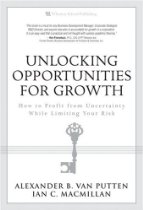In Unlocking Opportunities for Growth: How to Profit from Uncertainty While Limiting Your Risk, authors Alexander B. van Putten and Ian C. MacMillan offer a tool they call Opportunity Engineering (OE), which shows companies how to engineer the risk out of uncertain opportunities in order to pursue more high-payoff innovations. OE, the authors note, is both a tactical approach and a mindset. It provides a specific way of valuing opportunities, using proprietary software, that enables companies to plug in the parameters of a project and determine its potential quickly. In short, the authors say, OE helps inculcate a culture of innovation. Below is an excerpt from their book.
A day does not go by without someone in the business media waxing eloquent about the pace of change, the increasing turbulence of technology, or the massive pressures of global competition. Writers and broadcasters go on and on about the increasing uncertainty this brings about, and all this uncertainty is generally couched as threatening. This foreshadowing is astonishing when you consider that boundless opportunities for big-win investments can lurk within uncertainty — uncertain yes, but with huge upside potential nonetheless.We asked ourselves what causes firms and managers to generally regard uncertainty as a negative, when in fact opportunities for unusual prosperity lie in being able to exploit that very uncertainty. As we looked into the reasons why managers do not forge prosperity out of uncertain investments, we decided that it is really not their fault! We found that managers have not been given the right tools for investing in uncertain times. They are in the grips of a “Go/No Go vise,” using tools for investment analysis that were created for more stable times. Discounted cash flow (DCF) calculations and net present value (NPV) analysis have them fixated on “making their numbers” or being treated as failures. These blinkers keep them locked into a Go/No Go decision-making pattern, either proceeding full steam ahead or stopping in their tracks (which, in the face of uncertainty, is usually No Go), when in fact they could be engineering the risk out of uncertain opportunities and going for high potential wins by slicing out their downside and boosting their upside.
The problem with the traditional approach (i.e., NPV) is that after an idea for a new product or service has been assessed and given the green light by senior management, and the development team lays out a project plan, they are expected to turn the idea into an asset that delivers expected returns; otherwise, they have failed. [It is] classic Go/No Go thinking. It seems logical, but it has the unintended consequence of stopping innovation dead in its tracks, and it often piles up large losses, too. Why? Because if an idea has to turn into an asset “or else,” the logical response is to focus on low-risk ideas that are close to a company’s current offerings — those that are a safer bet. This conservatism might make sense for the individual manager, but if it becomes the norm it keeps companies focused on what worked in the past rather than focused on the future, where the opportunities for high growth lie. This risk avoidance snuffs out the experimentation and innovation that lay at the heart of all great companies’ history, when their entrepreneurial spirit ran high. Indeed, from our consulting work, we suspect that many managers self- select out high-potential, uncertain ideas because they are afraid of being wrong and being criticized for it. This fear causes a narrow focus on incremental changes to existing products. The question is, can anything be done to change this deadly dynamic?
Something can be done. For the past four years, we have been working on bringing you the right tool to manage beyond Go/No Go. We found it in something that we call Opportunity Engineering (OE), which allows you to assess uncertain opportunities and find ways of selecting only those where you can engineer the chance to capture their high upside potential and slice out the downside. OE allows you to select and pursue ideas that reach a long way into the upside potential and wrench out profits, while at the same time allow you to contain your risk to little more than your existing business risk.
Making Uncertainty Work for You
The key concept of OE is making uncertainty work for you rather than against you. In most uncertain projects, the potential profits have a probability distribution…. If (and only if) you can Opportunity Engineer the project, you can in fact “slice out” the downside risk by engineering the opportunity so that the left tail of the distribution is removed, giving you an asymmetric
return in which the actual probability of profits is confined to the opportunity space. [The book offers figures to show this.] This opportunity space is bought at the engineered cost, which is all you need to risk to “buy” the rights to the potential upside offered by the project. If you cannot create this asymmetry, and the downside risk remains, you do not have an Engineered Opportunity, you have a WAG (wild-ass gamble)!
The importance of this insight is that now the more uncertain a project is, the better! Uncertainty widens the curve because there exists a larger universe of possible returns. More of the profits will be to the right along the curve where there is a greater chance of a higher profit, while there is no chance of a loss beyond the engineered cost. This probability distribution usually causes a good deal of discussion with executives we advise — it is a completely different way of thinking, but it makes sense as long as you can control the downside.
The same reasoning lies behind stock options in the financial markets: The greater the uncertainty surrounding a stock, the greater the option value, because the downside risk is limited to the price of the option. Therefore, higher uncertainty allows for a bigger potential upside win with a controlled exposure to a downside loss, namely the option’s cost. For the same price, would you rather have an option on Google (a proxy for high uncertainty) or on P&G (a proxy for low uncertainty)? Google, of course!
The disconnect between traditional financial valuations and management intuition results from a bias against uncertainty. But a situation that is uncertain has to have some positive context, or else it is not uncertain. It is just plain bad. Right? So as long as the risk reward profile is designed to have a limited downside exposure coupled with a high upside — the asymmetric return that we discussed earlier — the more uncertain the project, the better! We call this positive uncertainty. It is at the heart of the transformational effect of OE.
Opportunity Engineering draws off the principles of real options analysis (ROA), which is a method for valuing uncertain investments, but goes well beyond
valuation to deliberately reconstruct investments to increase their value and
contain risk. OE creates a safe harbor where high-payoff, innovative investments can be aggressively pursued, because it changes the development process.
Instead of considering just whether Go or No Go, a project could be broken down into stages and dropped cheaply if the early stages aren’t working out, or a project once underway could be redirected to a different product or market, or the venture or the venture’s intellectual property could be sold off, or the project could be scaled up or slowed down or postponed, or the project could spawn a joint venture or precipitate a merger with another company. Clearly, OE opens up many possibilities, and usually none of these possibilities are evaluated when Go/No Go thinking is the norm.
Go/No Go as a decision-making model is simply too constraining, but it’s very understandable why companies stick with Go/No Go thinking. First of all, it’s what we were all taught in finance and accounting courses. Second, it is relatively easy to manage, whereas managing uncertainty is not. The trick is to engineer into the project early indicators that convert the uncertainty into more certain knowledge, quickly and cheaply, so that you can redirect or shut down with minimum loss. In other words, fail fast, fail cheap, and move on to the real winners. That, in essence, is the key to OE and to this book.
OE is both a tactical approach and a mindset. In other words, it offers a specific way of valuing opportunities — we developed our own proprietary software that enables you to plug in the parameters of a project and determine its potential quickly and with minimal effort. Along the way, it helps inculcate a culture of innovation, where decision makers are not afraid to go after high-risk, high-opportunity bets.
In the next chapter, we show you how to begin this process of OE, but first let’s take a look at why NPV and DCF are right for some situations but wrong for others.
NPV and DCF: When and When Not to Use Them
As we alluded to earlier, the overuse of discounted cash flow analysis that leads to the ubiquitous NPV calculation is simply inappropriate when applied to uncertain investments, whether they are new products, entering new markets, or launching bold strategies. We think these tools have done much to stifle the entrepreneurial spirit in many companies. This is a strong statement, and we get pushback from many financial managers because NPV is the metric used across the board, so why rock the boat? Of course, our response is that rocking the boat is exactly how to find opportunities, especially if you are the first to do so.
This is not to say that NPV should be abandoned — far from it. Ultimately, the uncertainty in innovative projects will be engineered down to a point where using NPV is perfectly appropriate!
When to use NPV: So, let’s look at where DCF works and should be used. Discounted cash flow was “invented” to value corporate bonds. Here it is brilliant, because we know everything with a great deal of certainty. With a corporate bond, we know for sure what the time frame of the cash flow is by just looking at the indenture. If it is a 20-year bond, we have 240 monthly cash flow payments. The amount of each cash flow payment is also known for sure (from the indenture, by looking at the coupon rate). Therefore, the only unknown is the appropriate discount rate with which to present value the cash flows. Even this is easily determined in most cases by consulting one of the rating agencies such as Standard & Poor’s that gives a risk rating to a bond (e.g., AA). With the rating in hand, we look in the newspaper and might see that the spread for AA corporate bonds is 1.50% over Treasuries. We then add that 1.50% spread to the corresponding risk-free maturity to get the appropriate discount rate for the bond. Simple.
This logic was really quite brilliant at the time, and it was soon extended to valuing other, riskier investments. For example, in the 1950s, if Goodyear was considering building a factory, it could be valued in much the same way as a bond. The number of tires that the factory could produce during its useful life could be determined in advance from the plant capacity, and the profit margin from each tire could also be known with some assurance during those relatively stable times. With that information, it would be possible to model the cash flows to be derived from the factory during its life: [(Number of tires per year) x (Useful life of the factory) x (Expected margin per tire)]. The appropriate discount rate to adjust for risk could be determined from the rating given to Goodyear at the time to arrive at the correct spread over the corresponding Treasury rate. With the cash flows and the discount rate in hand, it was possible to arrive at the present value of the factory, which if greater than the cost of the factory provided a positive NPV to the company, leading to the conclusion that the factory should be built. This all makes complete sense and is entirely appropriate in low-uncertainty environments.
When NPV does not work: DCF completely unravels when uncertainty rises and the original logic behind using NPV as a valuation methodology falls apart. As uncertainty increases, it becomes impossible to forecast future cash flows and their timing with any degree of confidence. In addition, high uncertainty makes it all but impossible to arrive at the appropriate discount rate. Worse still, the theory behind DCF analysis calls for the discount rate to increase along with uncertainty to adjust for the risk in the investment. The result is that uncertain investments are penalized with very high discount rates that diminish their perceived value. As a result, many interesting opportunities go unexplored because of what could be called “false negatives.”
Furthermore, the NPV formula reflects only one view of the future. In practice, managers may plug “high,” “most likely,” and “low” cash flow estimates into the formula to come up with three NPV values. Although this is better than taking one look into the future, it still presumes one unalterable course of action; we start the project and finish the project, which has three different outcomes (high, most likely, and low), and we cannot change direction along the way. NPV cannot effectively account for the value of being able to alter course during the investment implementation effort. There is no way to capture the value of flexibility that would allow for redirection, abandonment, speeding up, slowing down, and so on. Our solution starts by applying OE to harness the upside potential in your business.
In the next chapter, you learn about the underlying principles of OE. Before that, however, we want to stress that OE is not by any means some wild-eyed new theory. It draws off a lot of very solid work done over the years by many scholars who have used approaches such as decision trees, decision and risk analysis (DRA), real options analysis, and scenario analysis. OE’s main contribution is to extend beyond these approaches in two ways:
1. OE does not passively “accept” the parameters of the problem and proceed to valuing the opportunity, but rather challenges you to use the tools and your imagination to reengineer the opportunity and increase its value while driving down the risk. This is particularly valuable as a follow-on to scenario analysis.
2. The valuation of the opportunity, using the methodology we recommend, allows you to massively reduce the calculative complexity usually associated with DRA and real options approaches.
As this book unfolds, it will become apparent that the OE mindset has applications to almost all areas of business when uncertainty surrounds the outcome of the investment. In particular, OE will be of great value when selecting and managing R&D projects, mergers and acquisitions, and joint ventures and alliances. OE will also prove its value when entering new markets; designing, monitoring, and guiding major contract negotiations; and with strategic planning and scenario planning. How OE impacts these sorts of investments is discussed in detail in Chapter 6, “Applying Opportunity Engineering Throughout Your Business.”



